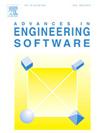Sub-population evolutionary particle swarm optimization with dynamic fitness-distance balance and elite reverse learning for engineering design problems
IF 4
2区 工程技术
Q2 COMPUTER SCIENCE, INTERDISCIPLINARY APPLICATIONS
引用次数: 0
Abstract
The main idea of particle swarm optimization (PSO) is to imitate the social behavior of birds, and the individuals in the algorithm can quickly converge to the optimal region of the solution space, to effectively find the optimal solution to the problem. When faced with high and complex optimization problems, it is easy to fall into local optimal solutions. To this end, this paper improved and optimized the original particle swarm optimization algorithm by introducing four stages, namely, the introduction of elite reverse learning strategy, dynamic fitment-distance balance (dFDB) strategy, subpopulation evolution strategy, factor adjustment and random position update strategy, and named the improved algorithm dFDBMPSO. Firstly, the diversity of the population is enhanced by introducing the elite reverse learning strategy in the initial stage. Secondly, in order to prevent the algorithm from identifying the optimal solution more effectively, dFDB policies are added to the algorithm to provide better guidance for the birds during the search process. In addition, subpopulation evolution strategy and random location update are introduced into the algorithm as new individual update methods, which makes the search method of birds in the algorithm more flexible. Finally, the formula factor of bird location update in the algorithm is adjusted to better balance the ability of global search and local search. In this paper, to test the performance of the proposed algorithm, the proposed algorithm is compared with a variety of comparison algorithms in different dimensions of the CEC2020 test set, four engineering design problems, two other truss topology optimization problems, and parameter optimization problems based on VCCS-FOPID vehicle control system. The experimental results show that the newly developed algorithm is superior to the previous algorithm. In addition, a new grey prediction model RC_TDGM (1,1,r,ξ, Csz) based on triangular residual correction and dFDBMPSO is proposed and applied to the forecast of global biofuel production. The predicted results are closer to the trend of the original data, which further verifies the competitiveness of the algorithm.
求助全文
约1分钟内获得全文
求助全文
来源期刊

Advances in Engineering Software
工程技术-计算机:跨学科应用
CiteScore
7.70
自引率
4.20%
发文量
169
审稿时长
37 days
期刊介绍:
The objective of this journal is to communicate recent and projected advances in computer-based engineering techniques. The fields covered include mechanical, aerospace, civil and environmental engineering, with an emphasis on research and development leading to practical problem-solving.
The scope of the journal includes:
• Innovative computational strategies and numerical algorithms for large-scale engineering problems
• Analysis and simulation techniques and systems
• Model and mesh generation
• Control of the accuracy, stability and efficiency of computational process
• Exploitation of new computing environments (eg distributed hetergeneous and collaborative computing)
• Advanced visualization techniques, virtual environments and prototyping
• Applications of AI, knowledge-based systems, computational intelligence, including fuzzy logic, neural networks and evolutionary computations
• Application of object-oriented technology to engineering problems
• Intelligent human computer interfaces
• Design automation, multidisciplinary design and optimization
• CAD, CAE and integrated process and product development systems
• Quality and reliability.
 求助内容:
求助内容: 应助结果提醒方式:
应助结果提醒方式:


